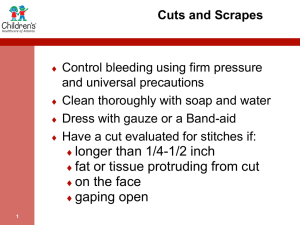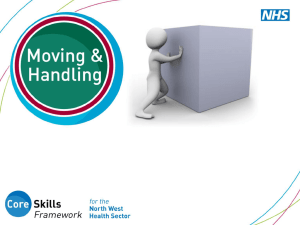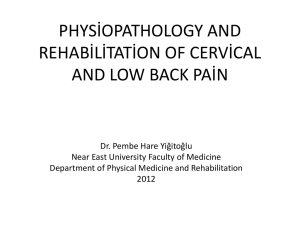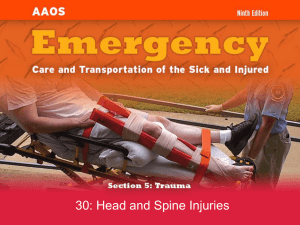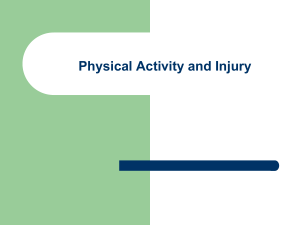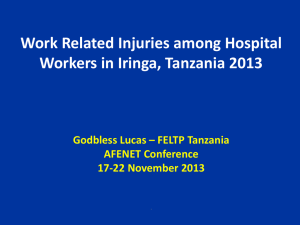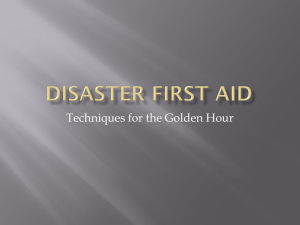Cervical Spine Injuries
advertisement
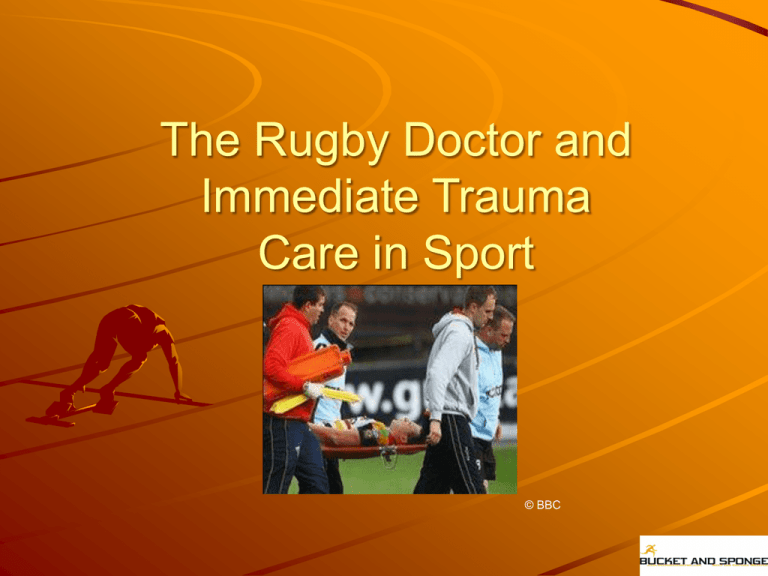
The Rugby Doctor and Immediate Trauma Care in Sport © BBC John Morgan GP Partner (Wigan) Clinical Director Bucket and Sponge Medical Services GPSI Sports Medicine (North West) Member of Joint Consultative Forum for Exercise Referral GP Tutor Manchester University Medical School Field Placement Supervisor Salford University Sports Rehab & Physiotherapy Chief Medical Officer Ireland Rugby League Key Note Lecture BASRaT 2012 Duties of Team Doctor • coordinating pre-participation screening, examination, and evaluation • field-side assessment and triage • managing injuries on the field • providing for medical management of injury and illness • coordinating rehabilitation and return to participation • integrate medical expertise with other health care providers • provide appropriate education and counselling regarding nutrition, strength and conditioning, ergonomic aids, substance abuse, and other medical problems that could affect the player • develop and maintain a current , appropriate knowledge base of the sport, understanding current techniques for managing sport injuries Code of Ethics For The Team Doctor The Team Doctor must: • Be primarily responsible for the safety and well-being of the athlete • Abide by the guiding regulations of the medical profession • Abide by the rules of the sport governing body • Must seek other medical opinions when in doubt, and then integrate this expertise as provided • Preserve confidentiality in all circumstances • Must not seek secondary gain from commercial interests that in any way would alter that which is in the best interest of the athlete Immediate Medical Management on the Field of Play (IMMOFP) • Mandatory qualification required by RFL for medical personnel entering the field of play • Must be a currently registered medical practitioner or a Chartered and State registered Physiotherapist with a degree in Physiotherapy • Qualification is valid for two years • Renewal of qualification must be achieved within two months of expiry or you are prohibited from entering the field of play Medical Personnel Super League Requirements For home and away matches: • Physiotherapist – CSP and HPC registered with a degree in physiotherapy and current IMMOFP qualification • Doctor – Qualified, registered with GMC and practicing with current IMMOFP qualification Source: Medical Standards – 2011 provided by RFL Medical Personnel Championship Requirements For home matches:• Physiotherapist – CSP and HPC registered with a degree in physiotherapy and current IMMOFP qualification • Doctor – Qualified, registered with GMC and practicing with current IMMOFP qualification The Doctor is to remain for at least 15 minutes following the end of the match and to check with the away team physio (if they do not have a Doctor present) to confirm his/her services are not required before leaving the dressing room area. For away matches:• Physiotherapist – CSP and HPC registered with a degree in physiotherapy and current IMMOFP qualification Source: Medical Standards – 2011 provided by RFL Medical Personnel Academy,U20s, U23s and Scholarship Requirements For home matches:• Physiotherapist – CSP and HPC registered with a degree in physiotherapy and current IMMOFP qualification • Doctor – Qualified, registered with GMC and practicing with current IMMOFP qualification Where a qualified medical practitioner is unavailable, as a last resort the club may hire a qualified paramedic, operating through a private paramedic company who is on duty and fully equipt by that company. For the avoidance of doubt it is still the responsibility of the home club to provide the Mandatory Medical Equipment. If a paramedic is being used then the visiting club should be informed in advance. The RFL Operations Department must be informed of the name of the company concerned. For away matches:• Physiotherapist – CSP and HPC registered with a degree in physiotherapy and current IMMOFP qualification Source: Medical Standards – 2011 provided by RFL Mandatory Medical Equipment The following equipment must be in the dressing room at least 1 hour before kick-off:• Spinal Board and Trained Stretcher Bearers • Cervical Stiff neck Collar(s) • Splints • Airways including a selection of ALL of the following: Oropharyngeal airway (assorted sizes) Nasopharyngeal airway (assorted sizes) Pocket Mask (1 way valve) • Automated External Defibrillator • Portable Suction • Oxygen Mandatory Medical Equipment • Emergency Drug Box containing: Adrenaline 1:1000 1ml vial 2 vials Hydrocortisone 100mg for IV administration (200mg dose) Chlorpheniramine (Piriton) 10mg in 1ml vial for IV/IM use 10mls water for injection Diazepam IV IM injection 10mg in 2ml vial Salbutamol UDV 5mg per 2 mls 300mg Aspirin IV fluids 500ml Sodium chloride 0.9% IV giving set Venflon – one of each Green/Blue/Orange needles (3 of each) 1ml, 2ml, 5ml, 10ml syringes (2 of each) Mandatory Medical Equipment • Foil blanket and Ambulance blanket • Sharps Bin and Clinical Waste Bag • Bleach Solution and Disposable Gloves Highly Recommended but not Mandatory Equipment • Entonox • Emergency Cricothyotomy Device and/or needle Cricothyotomy Equipment • Crutches • Penlight Torch Additonal Recommended Equipment • Various ET tubes • Laryngoscope • Stethoscope • Sphygmomanometer • Various needles, syringes – in addition to those in drug box • Adrenalin 1:10,000 plus additional 1,000 or epipen • Suture Kit • Eye irrigation materials • Emergency cricothyroidotomy kit • Anti-inflammatories (tablets/IM) • Painkillers (check WADA Prohibited List) (Tablets/IM) Additonal Recommended Equipment • • • • • • • • • Anti-emetics Anti-fungals Antibiotics (various) Medipreps Gauze Swabs Scissors Inhalers - Salbutomol Jelly Babies/Lucozade Tablets Other drugs you personally feel necessary to carry out your duties Additionally all medics should have:• Effective means of communication with emergency services • Sound knowledge of additional medical persons at ground • Detailed knowledge of treatment room facilities The Preparticipation Examination: Preventing injury • Recent development in sports medicine • Completed at start of Pre-Season training • Used to: Assess overall health Detect conditions that may cause injury Detect conditions that may disqualify the player from participating Assess fitness Make recommendations for the exercise program Components of the Pre-participation Examination • Medical history • Musculoskeletal examination • Family/Social History • General medical health evaluation • 100% ME talk • Cardiac Screening ECG Echocardiography Report – if required • Consent Medical Treatment Information • COGSPORT Rugby League is an ‘international collision sport‘ with an elevated risk of injury, compared with many other popular international sports. Some investigations have indicated that injury rates in rugby-league play are as high as 1.4 serious injuries per game, and the frequency of injury in the sport seems to be increasing rather than decreasing ‘A Prospective Study of Injuries to Élite Australian Rugby Union Players,‘ British Journal of Sports Medicine, Vol. 36, pp. 265-269, 2002 Basic Life Support Three elements: Airway – establishment of an airway Head Tilt / Chin Lift or Jaw Thrust Jaw thrust should be used to open the airway if an injury to the Cspine is suspected Adjuncts should be used if required Breathing – artificial ventilation of the lungs Circulation – artificial circulation of blood through the body Alex Thompson Scene Safety • Most Important Person is YOU • Is Area safe and game stopped? • No matter how well equipped you are hospital may be the most appropriate place for treatment • Don’t forget to request an ambulance as early as possible • Collapse Witnessed? • If not – consider more unusual causes Aims of Treatment • Preserve Life • Maintain an Airway • Perform CPR • Stop Bleeding • Prevent the Situation Deteriorating • Summon Help • Use First-Aiders or Bystanders • Promote Recovery • Reassure Patient • Wrap in a Blanket Priorities of Treatment • In all patients involved in trauma it is important to immobilise the head and neck until a C-spine injury is ruled out • Treatment of a player and their injuries should be dealt with in the following order: • If any life threatening problem is found it should be dealt with immediately before moving on to the next stage • Breathing • Airway – ensure the airway is patent • Breathing – patient is breathing and respirations are adequate • Circulation – the patient has a palpable carotid pulse • Bleeding – ensure there is no major bleeding • Bones – Examine the patient for any fractures Sudden Cardiac Death 7 deaths in Rugby League 19962011 Unconsciousness Causes: • Head injury • Asphyxia • Skull fracture • Fainting • Concussion • Extremes of body temperature • Compression • Cardiac arrest • Cerebrovascular accident • Hypoglycaemia • Epileptic fits • Hyperglycaemia • Infantile convulsion • Hypothermia • Hysteria • Blood loss • Poisonous substances and fumes • Drug overdose Management of an unconscious patient • AcBCDE – airway must always take priority • If in doubt treat as a C-spine injury! • If YES to any of following, continue with Full Spinal Immobilisation 1. Decreased conscious levels? 2. Any loss of consciousness post incident? 3. Under the influence of drink/drugs (including prescription medication)? 4. SIGNIFICANT neck or back pain? 5. Deformity, tenderness, swelling over the spinal process? 6. Neurological signs and symptoms? 7. Other painful injuries? 8. Significant pain on moving the neck or back? Levels of Response – AVPU Scale Alert The casualty is fully alert They are responsive and fully orientated (a casualty in this category will usually know what month it is)` Voice Confused The casualty is not fully orientated but asks and answers your questions Inappropriate words The patient is able to speak words, but cannot put them together into logical sentences Utter Sounds The casualty is not able to speak words but makes noises often in response to painful stimuli No verbal response The casualty makes no noise Pain Localises pain The patient is able to localise where painful stimuli is being applied Responds to (but does not note localise) pain The patient responds to painful stimuli, but is unable to localise it Unresponsive Unresponsive Spinal and Cervical Injuries Mechanism of Injury Caused by direct or indirect violence and should always be suspected in all cases where: • There is a history of accident or injury to the vertebral column • The patient complains of pain in the back or neck • There has been hyper-flexion or whiplash injuries of the neck • A heavy weight has fallen on the casualty’s shoulders • A fall from a height and landing on the heels has occurred • There is acceleration or deceleration strains of the neck • An unconscious patient has been involved in a road traffic accident Spinal and Cervical Injuries Signs and Symptoms of a Spinal Injury As well as normal signs and symptoms of fracture, there may be other clinical features which are specific to a spinal injury • Loss of feeling or sensation in the body below the site of the injury • A hot feeling, or ‘pins and needles’ sensation above the site of the injury • Paralysis or generalised weakness below the injury site, which may lead to incontinence • Displacement of the spinal vertebrae felt as an unnatural lump, or depression, from the normal continuity of the spinal column • Fixation of the spinal column at the site of injury Spinal and Cervical Injuries Management of Spinal Injuries • Ensure an open airway using jaw thrust technique • Do not move the patient unless there is immediate danger • Avoid rotation or extension/flexion of the neck • Manual immobilisation of the patient is paramount. Once applied it should not be released until the patient is firmly strapped to the spinal board and head blocks are applied • Apply a correctly sized collar, remembering that this will only provide 30% support and manual immobilisation must continue to be applied • Spinal injuries can be masked particularly in a patient with multiple injuries. A thorough secondary survey is important to establish the site of the injury • If in doubt as to the presence of a spinal injury, you must immobilise the patient, prevention is better than cure! • Immobilise the patient to a spinal board using as much help as possible • The person who is controlling the head must give all the movement commands in a clear and precise way to eliminate the risk of jerky uncoordinated movements Waiting for the ambulance service to assist in the movement of this type of patient is usually the best idea • Spinal and Cervical Injuries Specific to the Cervical Spine on the field of play Stinger or Burner • A soft tissue injury to the cervical spine which is quite common in rugby league • It is a traction injury occurring with cervical side flexion and simultaneous shoulder depression • Usually caused by nerve root compression in the upper root of the Brachial plexus (C5/6) • Symptoms are burning/tingling in the lateral arm, thumb and index finger • Usually transient and often player can be seen to ‘shake off’ symptoms in his arm and does not require him to be removed from the field of play • Muscles involved are deltoid, biceps and infraspinatus • A weakness in any of these muscles on assessment means that the player should be removed and not return to the field of play during that game Cervical Spine Injuries Classification of injuries Harris usefully classified cervical spine injuries according to the mechanism of injury and the subsequently expected pattern of fractures into the following groups:• Axial loading • Flexion injury • Hyperextension injury • Flexion + Rotation • Extension + Rotation • Odontoid peg fractures all of which may occur in a rugby match It is important to know when and why these injuries must be suspected as well as how to manage them in the field of play Cervical Spine Injuries Clinical Suspicion Following ATLS guidelines, CSI must be suspected in any of the following circumstances:• Unconscious victim • Significant impact above clavicles • Immediate neck pain after an injury • Presence of step deformity in posterior midline of the neck • Presence of abnormal neurology • Significant distracting injuries • Significant MOI • Multiple trauma • Increased risk due to predisposing factors (general abnormalities, old age, neck injuries) Cervical Spine Injuries Clinical Exclusion Before a CSI can be clinically excluded, the patient must satisfy the following criteria:• GCS 15/15 on assessment and all of these • Not under effects of alcohol or drugs • No pain on palpation • No pain on movement (see Canadian Cervical Spine Rule) • No abnormal neurology • No significant distracting injury Cervical Spine Injuries Canadian Cervical Spine Rule Canadian researchers devised an algorithm for selective cervical spine radiology The algorithm classifies the patients as having a low probability of injury (sensitivity 99.6%) if the patient meets the next 5 criteria:• No mid-line cervical tenderness on direct palpation • No focal neurological deficit • Normal alertness • No intoxication • No painful distracting injuries This helps to eliminate any unnecessary investigations and, therefore reducing cost and wasteful overuse of medical resources at the same time as minimising exposure to unnecessary radiation PRACTICAL!



